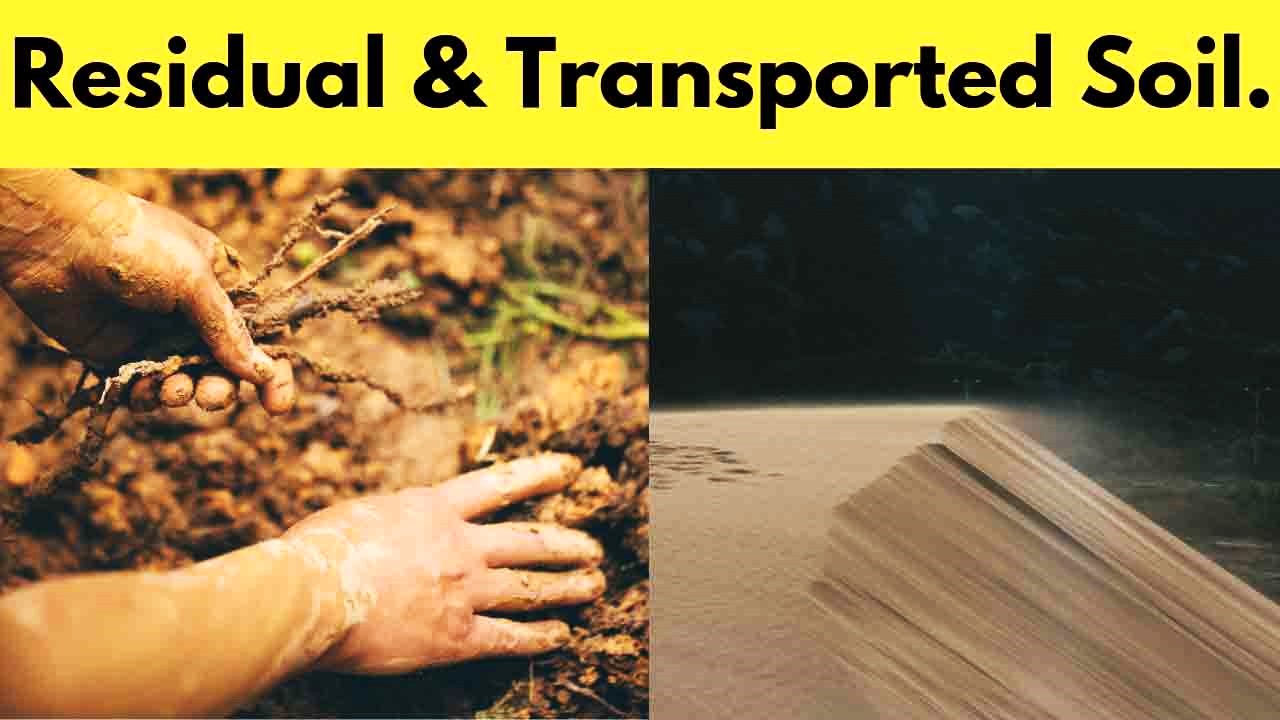Home>Science>Residual Soil Vs. Transported Soil: Unveiling The Hidden Secrets Of Earth’s Mysterious Layers


Science
Residual Soil Vs. Transported Soil: Unveiling The Hidden Secrets Of Earth’s Mysterious Layers
Published: January 20, 2024
Discover the differences between residual and transported soil layers, unraveling the mysteries of Earth's geological composition. Explore the science behind soil formation and its impact on the environment.
(Many of the links in this article redirect to a specific reviewed product. Your purchase of these products through affiliate links helps to generate commission for Noodls.com, at no extra cost. Learn more)
Table of Contents
- Introduction
- Understanding Soil Formation
- Residual Soil: The Product of In-Situ Weathering
- Transported Soil: The Journey of Sediments
- Contrasting Characteristics of Residual and Transported Soil
- Importance of Differentiating Between Residual and Transported Soil
- Unveiling the Hidden Secrets of Earth's Mysterious Layers
Introduction
Soil, the very foundation of life on Earth, holds within its humble appearance a rich tapestry of history and natural processes. From the vast plains to the highest mountains, soil forms a vital layer that sustains ecosystems and supports the growth of diverse plant life. Yet, beneath its seemingly unassuming surface lies a profound story of geological transformations and environmental influences.
In this article, we embark on a journey to unravel the enigmatic nature of Earth's soil, focusing on the intriguing dichotomy between residual and transported soil. By delving into the distinct characteristics and formation processes of these soil types, we aim to shed light on the hidden secrets that shape the Earth's mysterious layers.
As we delve into the depths of soil science, we will uncover the intricate mechanisms that give rise to residual and transported soil. Through this exploration, we will gain a deeper understanding of the geological forces at play, and the profound impact they have on the landscapes we inhabit. Join us as we unravel the mysteries concealed within the Earth's soil, and discover the remarkable tales that lie beneath our feet.
Understanding Soil Formation
Soil formation is a complex and dynamic process that unfolds over geological timescales, sculpted by a myriad of interwoven factors. At its core, soil formation is a testament to the ceaseless interplay between geological, biological, climatic, and topographical forces. The intricate dance of these elements gives rise to the diverse array of soils that blanket the Earth's surface, each bearing the indelible imprint of its unique environmental history.
The process of soil formation, known as pedogenesis, encompasses a series of transformative stages. It begins with the physical and chemical weathering of parent material, such as rocks and minerals, which sets the stage for the gradual development of soil horizons. Over time, the gradual breakdown of parent material, facilitated by factors such as temperature fluctuations, moisture levels, and biological activity, yields the raw materials for soil formation.
As the weathered particles accumulate, they undergo a process of transformation, giving rise to distinct soil horizons characterized by variations in color, texture, and composition. This intricate layering reflects the cumulative impact of environmental factors and biological processes, which imbue each soil profile with a unique set of properties and characteristics.
Furthermore, the role of organic matter cannot be overstated in the formation of soil. The gradual decomposition of plant and animal residues infuses the soil with vital nutrients and organic compounds, fostering the development of a fertile and hospitable environment for plant growth. This organic contribution enriches the soil, endowing it with the capacity to support diverse ecosystems and sustain complex food webs.
In essence, soil formation is a testament to the intricate interplay of geological processes, climatic dynamics, and biological interactions. It is a testament to the Earth's remarkable capacity for regeneration and renewal, as well as a testament to the profound influence of soil on the ecosystems and landscapes it sustains. As we delve into the realms of residual and transported soil, it is essential to appreciate the intricate processes that underpin their formation, and the profound impact they have on the natural world.
Residual Soil: The Product of In-Situ Weathering
Residual soil, a testament to the enduring forces of in-situ weathering, emerges as a product of the relentless interplay between geological substrates and environmental influences. This unique soil type takes shape through the gradual disintegration and decomposition of the underlying bedrock, a process that unfolds directly in place, without the displacement of weathered materials. As the bedrock undergoes successive cycles of physical and chemical weathering, it gives rise to residual soil, which retains a profound connection to its parent material and the geological forces that have shaped it.
The formation of residual soil is intricately linked to the composition and characteristics of the underlying bedrock. In regions dominated by igneous or metamorphic rocks, residual soils often bear the indelible imprint of their parent material, exhibiting similar mineralogical compositions and physical properties. The slow and steady weathering of these rocks yields residual soils with distinct profiles, characterized by the presence of residual minerals and the gradual accumulation of weathered particles.
Furthermore, the topographical features of a region play a pivotal role in shaping the development of residual soils. Slopes, valleys, and plateaus exert a profound influence on the distribution and composition of residual soils, as they dictate the patterns of erosion and sedimentation. In areas characterized by steep slopes, the accumulation of residual soil may be limited, as the weathered particles are more susceptible to erosion and transport. Conversely, in flat or gently sloping terrains, residual soils may accumulate over time, forming extensive layers that reflect the geological heritage of the region.
The properties of residual soil are deeply intertwined with the processes of in-situ weathering that give rise to them. These soils often exhibit a high degree of cohesiveness and stability, owing to their close association with the underlying bedrock. Additionally, residual soils tend to retain a significant portion of their parent material's mineral composition, which can profoundly influence their fertility and capacity to support plant life.
In essence, residual soil stands as a testament to the enduring legacy of geological processes, encapsulating the intricate interplay between bedrock weathering, environmental dynamics, and topographical influences. As we unravel the mysteries of residual soil, we gain a profound appreciation for the profound connections that bind the Earth's surface to its geological origins, and the remarkable stories that lie embedded within the layers of soil.
Transported Soil: The Journey of Sediments
Transported soil, a product of the relentless forces of erosion and sedimentation, embarks on a remarkable journey that spans vast distances and geological timeframes. Unlike residual soil, which forms in-situ through the weathering of underlying bedrock, transported soil undergoes a transformative odyssey, carried by the ceaseless movement of sediments across the Earth's surface. This journey, shaped by the dynamic forces of wind, water, and ice, gives rise to a diverse array of transported soils, each bearing the indelible imprint of its geological origins and the environmental forces that have propelled it across the landscape.
The genesis of transported soil lies in the erosive forces that sculpt the Earth's terrain, dislodging particles from their original location and setting them in motion. Water, a powerful agent of erosion, plays a pivotal role in the transport of soil particles, as it carries sediments along riverbeds, streams, and floodplains, shaping the contours of the land as it flows. The ceaseless action of wind, too, contributes to the movement of soil particles, dispersing them across vast expanses and shaping the dunes and deposits that characterize arid landscapes. In glacial regions, the inexorable advance and retreat of ice sheets transport vast quantities of sediments, leaving behind a legacy of transported soils that bear witness to the profound influence of glacial dynamics.
As these sediments traverse the Earth's surface, they undergo a series of transformative processes that imbue them with distinct characteristics and properties. The journey of transported soil may involve periods of deposition, where sediments come to rest in new locations, forming layers that reflect the dynamic history of their transport. Over time, these deposits may undergo further modification, as compaction and cementation processes give rise to sedimentary rocks, perpetuating the geological legacy of transported soils.
The properties of transported soil are deeply intertwined with the nature of their journey, reflecting the influences of transport mechanisms, depositional environments, and the characteristics of the parent material. In regions shaped by fluvial processes, transported soils may exhibit a diverse range of particle sizes and compositions, reflecting the dynamic interplay of waterborne sediments. In arid landscapes, windblown soils may bear the distinctive imprint of aeolian transport, characterized by fine-grained particles and unique sedimentary structures. Glacially transported soils, on the other hand, may bear the unmistakable hallmarks of their icy origins, reflecting the tumultuous history of ice-driven transport.
In essence, transported soil embodies the enduring legacy of erosive forces and sedimentary dynamics, bearing witness to the ceaseless movement of Earth's materials across its surface. As we unravel the mysteries of transported soil, we gain a profound appreciation for the profound connections that bind the Earth's landscapes to their geological origins and the remarkable stories that lie embedded within the layers of soil.
Contrasting Characteristics of Residual and Transported Soil
Residual soil and transported soil, while both integral components of the Earth's diverse soil cover, exhibit strikingly contrasting characteristics that reflect their distinct origins and geological histories. These disparities encompass a myriad of physical, chemical, and compositional attributes, each serving as a testament to the unique processes that have shaped these soil types.
Residual soil, born from the in-situ weathering of underlying bedrock, maintains a profound connection to its geological origins. Its composition often mirrors that of the parent material, retaining a high concentration of residual minerals and exhibiting a close association with the underlying rock formations. In contrast, transported soil, having traversed significant distances through the agency of erosive forces, reflects a diverse array of parent materials and exhibits a broader range of particle sizes and compositions. This fundamental distinction underscores the profound influence of transport mechanisms on the characteristics of soil, shaping its properties in response to the dynamic forces of wind, water, or ice.
Furthermore, the physical properties of residual and transported soils diverge in notable ways. Residual soils, owing to their close association with the underlying bedrock, often exhibit a high degree of cohesiveness and stability, with well-defined horizons that reflect the gradual weathering of the parent material. In contrast, transported soils may display a more heterogeneous structure, reflecting the varied depositional environments and transport mechanisms that have shaped them. These differences manifest in the diverse textures and structures exhibited by transported soils, which bear the imprint of their dynamic journey across the Earth's surface.
Chemical characteristics further delineate the contrasting nature of residual and transported soils. Residual soils, enriched by the gradual decomposition of underlying bedrock, often exhibit a higher concentration of weathering products and residual minerals, contributing to their fertility and capacity to support plant life. In contrast, transported soils may display a broader range of chemical compositions, influenced by the diverse parent materials encountered during their journey. This diversity engenders a rich tapestry of soil types, each bearing the chemical signatures of their geological origins and transport mechanisms.
In essence, the contrasting characteristics of residual and transported soil encapsulate the profound influence of geological processes and environmental dynamics on the Earth's soil cover. These disparities serve as a testament to the intricate interplay of weathering, erosion, and sedimentation, which imbue each soil type with a unique set of properties and characteristics. By unraveling these distinctions, we gain a deeper appreciation for the remarkable diversity of soils that blanket the Earth's surface, each bearing the indelible imprint of its geological heritage.
Importance of Differentiating Between Residual and Transported Soil
Distinguishing between residual and transported soil holds profound significance in the realms of geology, agriculture, and environmental science. This differentiation serves as a linchpin in deciphering the intricate stories embedded within the Earth's soil cover and illuminates the diverse influences that shape our natural landscapes. By discerning the unique characteristics and origins of these soil types, scientists and land managers can glean invaluable insights into the geological history, fertility, and ecological dynamics of a given region.
In the domain of geology, the differentiation between residual and transported soil provides crucial clues about the geological heritage and environmental processes that have shaped a particular landscape. Residual soil, closely linked to its parent material, offers a window into the geological substrates and weathering mechanisms that have sculpted the terrain over millennia. By studying the properties and composition of residual soil, geologists can unravel the complex history of bedrock weathering and gain insights into the geological forces that have shaped the Earth's surface.
In agricultural contexts, the distinction between residual and transported soil assumes paramount importance in understanding soil fertility, nutrient dynamics, and land management practices. Residual soils, with their close association with underlying bedrock and accumulation of weathering products, often exhibit distinct fertility profiles that influence their capacity to support plant growth. By contrast, transported soils may vary widely in their nutrient content and physical properties, reflecting the diverse parent materials and transport mechanisms that have shaped them. This differentiation is essential for tailoring agricultural practices to the specific characteristics of the soil, optimizing crop yields, and mitigating the environmental impacts of farming activities.
Moreover, in the realm of environmental science, the differentiation between residual and transported soil plays a pivotal role in unraveling the ecological dynamics and habitat suitability of a given region. Residual soils, with their intimate ties to the underlying bedrock and geological history, often harbor unique ecosystems and plant communities that are adapted to the specific properties of these soils. In contrast, transported soils may exhibit a broader range of ecological niches, reflecting the diverse parent materials and depositional environments encountered during their journey. Understanding these distinctions is crucial for conservation efforts, habitat restoration, and the preservation of biodiversity in diverse landscapes.
In essence, the importance of differentiating between residual and transported soil transcends disciplinary boundaries, offering profound insights into the geological, agricultural, and ecological dimensions of our natural world. By unraveling the unique characteristics and origins of these soil types, we gain a deeper appreciation for the intricate tapestry of forces that shape the Earth's landscapes and the remarkable stories that lie concealed within the layers of soil.
Unveiling the Hidden Secrets of Earth's Mysterious Layers
The enigmatic layers of Earth's soil conceal a wealth of hidden secrets, each layer bearing the indelible imprint of geological forces, environmental dynamics, and the intricate interplay of natural processes. Unraveling these mysteries unveils a profound tapestry of history and transformation, offering insights into the deep-seated connections that bind the Earth's landscapes to their geological origins.
At the heart of this enigma lies the intricate dichotomy between residual and transported soil, each embodying a unique chapter in the Earth's geological narrative. Residual soil, a product of in-situ weathering, stands as a testament to the enduring legacy of bedrock transformations, retaining a profound connection to its parent material and the geological forces that have shaped it. In contrast, transported soil embarks on a remarkable journey, propelled by the relentless forces of erosion and sedimentation, bearing witness to the ceaseless movement of Earth's materials across its surface.
Delving into the hidden secrets of these soil layers unveils a profound appreciation for the intricate processes that underpin their formation. It offers a glimpse into the geological substrates, weathering mechanisms, and environmental influences that have sculpted the Earth's terrain over millennia. Moreover, it provides crucial insights into the fertility, nutrient dynamics, and ecological niches that characterize these soil types, offering invaluable knowledge for geologists, agricultural practitioners, and environmental scientists.
Unraveling the mysteries of Earth's mysterious layers transcends disciplinary boundaries, offering profound insights into the geological, agricultural, and ecological dimensions of our natural world. It fosters a deeper appreciation for the intricate tapestry of forces that shape the Earth's landscapes and the remarkable stories that lie concealed within the layers of soil. As we continue to unveil these hidden secrets, we gain a newfound reverence for the profound connections that bind the Earth's surface to its geological origins, and the enduring legacy of natural processes that have shaped our planet's enigmatic layers.














